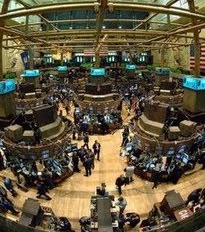Morning Market Review 08-31-10

Morning Market Review
Greek Factor: -1
You'll want to pay close attention to the Chicago PMI data today, as it will be the report that carries past morning trading. The slight uptick in consumer confidence was nice, but is negligible and not important when placed into context. Simply put, the reading still sucks, however better it may be than the last. The "Greek Factor" ranges from +3 to -3, and is a subjective measure of The Greek's view of the market impact of individual and aggregate news and the day's scheduled events.
Our founder earned clients a 23% average annual return over five years as a stock analyst on Wall Street. "The Greek" has written for institutional newsletters, Businessweek, Real Money, Seeking Alpha and others, while also appearing across TV and radio. While writing for Wall Street Greek, Mr. Kaminis presciently warned of the financial crisis.
Tickers: NYSE: MS, NYSE: BA, NYSE: HON, NYSE: NOC, NYSE: DHR, NYSE: GR, NYSE: HNZ, NYSE: ABM, Nasdaq: ARAY, Nasdaq: APSG, AMEX: BLD, NYSE: BNS, Nasdaq: CHOP, Nasdaq: CCUR, NYSE: CPY, NYSE: CFI, NYSE: DAC, NYSE: DG, NYSE: DSW, Nasdaq: ENER, NYSE: ENV, Nasdaq: FTLK, Nasdaq: ISLE, NYSE: KSP, Nasdaq: LLEN, OTC: LUKOY.PK, OTC: PSKNY.PK, Nasdaq: SGI, NYSE: SQM, Nasdaq: UNFY, NYSE: BEM, NYSE: SKS, NYSE: SKH, NYSE: LGF, NYSE: GG, NYSE: ETM, NYSE: CT, NYSE: MCP, NYSE: HL, NYSE: WLT, NYSE: CPY, NYSE: PRM, NYSE: RBS, NYSE: ANR, NYSE: CMA, NYSE: QTM, NYSE: PCX, NYSE: ABV, NYSE: IAG, NYSE: JCP, NYSE: CBC, NYSE: IOC, NYSE: SWC, Nasdaq: FCFL, Nasdaq: BNVID, Nasdaq: FSGI, Nasdaq: ZNWAW, Nasdaq: ARSD, Nasdaq: KONA, Nasdaq: AFOPD, Nasdaq: ENER, Nasdaq: EDAP, Nasdaq: SPSC, Nasdaq: RBNF, Nasdaq: KFED, Nasdaq: NSEC, Nasdaq: MPAC, Nasdaq: BLDR, Nasdaq: EFOI, Nasdaq: CASEYV, Nasdaq: KGJI, Nasdaq: TATT, Nasdaq: ICAD, Nasdaq: ALIM, Nasdaq: SCSS, Nasdaq: ARMH, Nasdaq: MEOH, Nasdaq: LGND, NYSE: DIA, NYSE: SPY, Nasdaq: QQQQ, NYSE: DOG, NYSE: SDS, NYSE: QLD, NYSE: NYX, NYSE: ICE, Nasdaq: NDAQ
Morning Market Review
 Tuesday is a busy day my dear traders, with six total reports scheduled, so your morning market review should come in handy in helping you make heads or tails of it all. Premarket releases came in the S&P Case Shiller Home Price Index, ICSC Weekly Sales data, and Canadian GDP. By 10:00 AM, we had another 4 reports, including Chicago PMI and Consumer Confidence.
Tuesday is a busy day my dear traders, with six total reports scheduled, so your morning market review should come in handy in helping you make heads or tails of it all. Premarket releases came in the S&P Case Shiller Home Price Index, ICSC Weekly Sales data, and Canadian GDP. By 10:00 AM, we had another 4 reports, including Chicago PMI and Consumer Confidence.S&P Case Shiller Home Price Index
Greek Factor: OUTDATED DATA
That's right, this is the best the producers of this data can do, June. By now we've seen pricing trends from the Existing Home Sales and New Home Sales report, and so the data is relatively worthless, except maybe for popular financial press on a slow day.
In any event, today's Home Price Index for June showed the HPI increased 4.4% in Q2. By now, you're all well aware of the fact that the tax incentive unnaturally boosted the second quarter data, and so you have nothing to look forward to based on Q2's rise. I would go so far as to say it's misleading to even publish this information so late, without qualification in that regard.
By the way, Q2's increase came after Q1's decline in prices of 2.8%. The report promotes the fact that quarterly prices are 3.6% higher than last year, but fails to note that last year marked generational low economic activity and that this year benefited from special stimulus.
17 out of 20 MSAs showed price increase in June. Also, the 10-City Composite rose 5%, while the 20-City measure increased 4.2%. Be careful folks, because you're learning about the past here, while studying irrelevant comparisons versus year ago; and every data point since has been miserable for housing. So before go believing popular press this morning, put this into perspective. The Chairman of the Index Committee even says so in the report, and I quote: "The monthly Composites cover June and the national index covers the second quarter, when the government's program for first time home-buyers was winding down. While the numbers are upbeat, other more recent data on home sales and mortgages point to fewer gains ahead."
I'm not wasting any more time on this data point, until it is relevant and timely, and neither should you. At least keep it in perspective and pay more attention to the Home Sales data, and pricing info therein.
ICSC Same-Store Sales
Greek Factor: 0
The International Council of Shopping Centers (ICSC) reported today on weekly same-store sales for the week ending August 28. After falling 0.4% last week, same-store sales increased 0.1% week-to-week. Warning sirens keep sounding on the news, and the year-over-year comparison gained 2.8% this week (low), versus last week's 2.3% rise. Back-to-school activity may be skewing things now, so be careful in reading too much into the activity of the next several weeks (on a weekly basis). Rather, look at the monthly data combined for August and September for a solid read. Redbook showed a 3.0% sales increase year-to-year, versus last week's +2.6% rate.
Chicago PMI
Greek Factor: -2
The Chicago Purchasing Managers Index was reported at 9:45 AM. Chicago offered bad news folks, and a few of the data points were down right dire within the report. Quoting ISM: "The Chicago Purchasing Managers reported the CHICAGO BUSINESS BAROMETER stumbled, marking an eleventh month of growth but indicating a decreasing breadth of expansion. Six of seven Business Activity indicators echoed the slowed expansion."
The seasonally adjusted index fell to 56.7, from 62.3 in July. This still reflects economic expansion (above 50). Economists were looking for the Chicago PMI's Business Barometer Index to mark 56.0 in August. Six of seven indicators reflected the headline index decline in pace. Production marked its biggest drop since October of 2008. New Orders fell to 55.0, from 64.6, which is highly concerning to me. Employment eased as well as inventories. Prices paid fell, so you deflation demons have fuel to fire. Capital equipment investment dropped sharply too. This is a negative report folks, and the market will likely grab a hold of it once economists get through with the release.
Consumer Confidence
Greek Factor: +1
Put this into perspective fellas. So what, the Conference Board's measure rose a bit to 53.5 in August. 53.5 sucks! I can't say it more clearly. This is a subjective survey, and so we cannot read too much into small changes. Economists were looking for 51.0, so stock traders took the report positively in the early go. I give it a positive mark because it beat expectations and traders have to trade on it a certain way in the short-short term. It should have no positive impact past today.
Canada's Q2 GDP
Canada reported its Q2 GDP figures Tuesday. Our northern neighbor's gross domestic product increased only 2%, versus economist expectations for a 2.5% increase. The Canadian dollar weakened against the USD on the news, down about a half a percentage point.
Investor Confidence
State Street (NYSE: STT) reports on Investor Confidence today. Last month's read saw global confidence increase 4.8 points to 96. Investor confidence improved in North America as well, rising 5.4 points to 99.9. This month's data is still not available.
FOMC Meeting Minutes
Greek Factor: This Release Matters Greatly
At 2:00 PM, the Federal Open Market Committee (FOMC) posts its meeting minutes for its latest gathering. The August 10 meeting purportedly featured some heated debate over starting up Bernanke's helicopter. This should make for an interesting read, as investors mull over the need for more help from the Fed.
Farm Prices
Agricultural goods prices for August are due at 3 PM.
Corporate News Drivers
Morgan Stanley's (NYSE: MS) Global Industrials Conference kicks off Tuesday. Look for presentations from Boeing (NYSE: BA), Honeywell (NYSE: HON), Northrop Grumman (NYSE: NOC), Danaher (NYSE: DHR) and Goodrich (NYSE: GR). H.J. Heinz (NYSE: HNZ) has a shareholders meeting scheduled.
Look for EPS from ABM Industries (NYSE: ABM), Accuray (Nasdaq: ARAY), Applied Signal Technology (Nasdaq: APSG), Baldwin Technology (AMEX: BLD), Bank of Nova Scotia (NYSE: BNS), China Gerui Advanced Materials (Nasdaq: CHOP), Concurrent Computer (Nasdaq: CCUR), CPI Corp. (NYSE: CPY), Culp (NYSE: CFI), Danaos (NYSE: DAC), Dollar General (NYSE: DG), DSW (NYSE: DSW), Energy Conversion Devices (Nasdaq: ENER), Envestnet (NYSE: ENV), Funtalk China (Nasdaq: FTLK), Isle of Capri Casinos (Nasdaq: ISLE), K-SEA Transportation (NYSE: KSP), L&L Energy (Nasdaq: LLEN), Lukoil (OTC: LUKOY.PK), Polski Koncern ADR (OTC: PSKNY.PK), Silicon Graphics (Nasdaq: SGI), Chemical & Mining Co. of Chile (NYSE: SQM) and Unify (Nasdaq: UNFY).
Today's biggest gainers so far: NYSE Gainers: Structured Product Capital (NYSE: BEM), Saks (NYSE: SKS), Skilled Healthcare (NYSE: SKH), Lions Gate Entertainment (NYSE: LGF), Goldcorp (NYSE: GG), Entercom Communications (NYSE: ETM), Capital Trust (NYSE: CT), Molycorp (NYSE: MCP), Hecla Mining (NYSE: HL), Walter Energy (NYSE: WLT), CPI Corp. (NYSE: CPY), Primedia (NYSE: PRM), Royal Bank of Scotland (NYSE: RBS), Alpha Natural Resources (NYSE: ANR), Comerica (NYSE: CMA), Quantum (NYSE: QTM), Patriot Coal (NYSE: PCX), Companhia de Bebidas das America (NYSE: ABV), IamGold (NYSE: IAG), J.C. Penney (NYSE: JCP), Capitol Bancorp (NYSE: CBC), Interoil (NYSE: IOC), Stillwater Mining (NYSE: SWC); Nasdaq Gainers: First Community Bank (Nasdaq: FCFL), Bionovo (Nasdaq: BNVID), First Security Group (Nasdaq: FSGI), Zion Oil & Gas (Nasdaq: ZNWAW), Arabian American Development (Nasdaq: ARSD), Kona Grill (Nasdaq: KONA), Alliance Fiber Optic (Nasdaq: AFOPD), Energy Conversion (Nasdaq: ENER), EDAP TMS (Nasdaq: EDAP), SPS Commerce (Nasdaq: SPSC), Rurban Financial (Nasdaq: RBNF), K-FED Bancorpo (Nasdaq: KFED), National Security Group (Nasdaq: NSEC), MOD-PAC (Nasdaq: MPAC), Builders FirstSource (Nasdaq: BLDR), Energy Focus (Nasdaq: EFOI), Casey's General STore (Nasdaq: CASEYV), Kingold Jewelry (Nasdaq: KGJI), TAT Tech (Nasdaq: TATT), icad (Nasdaq: ICAD), Alimera Sciences (Nasdaq: ALIM), Select Comfort (Nasdaq: SCSS), ARM Holdings (Nasdaq: ARMH), Methanex (Nasdaq: MEOH), Ligand Pharmaceuticals (Nasdaq: LGND).

Please see our disclosures at the Wall Street Greek website and author bio pages found there. This article and website in no way offers or represents financial or investment advice. Information is provided for entertainment purposes only.

Labels: Economic Reports, Premarket Report


































